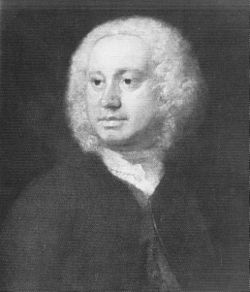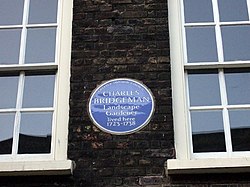Charles Bridgeman
| Charles Bridgeman | |
|---|---|
 | |
| Narození | 1690 |
| Úmrtí | 19.jul. / 30. července 1738greg. (ve věku 47–48 let) Velký Londýn |
| Povolání | zahradník a zahradník |
| Choť | Sarah Mist[1] |
| Některá data mohou pocházet z datové položky. | |
Charles Bridgeman (1690-1738) byl anglický zahradní architekt který stál na počátku vzniku přírodně krajinářského slohu v Anglii. Ačkoli on byl klíčovou postavou při přechodu anglických zahradě od pravidelného designu který se řídil podle holandských, italských a francouzských vzorů, formálních zahrad k volnějším stylům a byl mezi těmi kdo začali do pravidelných zahrad více vnášet nepravidelné prvky bývá Bridgemanova pověst často zastíněna jeho následovníky, kterými byl William Kent nebo Lancelot "Capability" Brown.
Charles Bridgeman byl synem zahradníka, který se stal královským zahradníkem anglické královny a prince Jiřího a byl původcem změn a rekonstrukcí v královské zahradě v Berkshire, Windsoru, Kensingtonském paláci, Hampton Court, St. James's Park and Hyde Park (Londýn). Pracoval na několika významných zahradách v Kentu, poskytoval odborné rady v Kentu což mu umožnilo realizovat jeho architektonické představy.[2]
Současník Bridgemana, Horace Walpole, popisuje design zahrad svého kolegy v práci eseji On Modern Gardening. Napsal zde "ačkoli stále ještě udržoval hodně úzké chodníky se stříhanými vysokými živými ploty, byly zde jen jako hlavní linie, zbytek zpestřil přirozenou divokostí a rozlehlými háji dubů, ovšem stále obklopenými keři" ( Amherst , 1896 , s. . 249).
Bridgemanův přístup k terénním úpravám lze shrnout do tří pojmů: formální, přechodná a progresivní. Jeho úpravy krajiny se vyznačovaly formálními prvky, jako jsou partery, geometricky tvarovaná jezera a bazény a malé pravidelné zahrady u domu. Přechodné prvky jeho prací včetně trávníků, amfiteátrů , zahradních staveb a soch, klikatých cestiček přes zalesněné oblasti k vyhlídkám a použití ha- ha jsou rysy a pokrokové myšlenky, kterým Bridgeman pomohl získat na popularitě. (Jellicoe , 1986 , s. . 72) .
Odkazy
Reference
V tomto článku byl použit překlad textu z článku Charles Bridgeman na anglické Wikipedii.
- ↑ Dostupné online.
- ↑ Philippe Prevot, Histoire des jardins, Editions Sud Ouest, 2006
- Amherst, Alicia. (1896). A History of Gardening in England. London: Bernard Quaritch.
- Batey, Mavis, David Lambert. (1990). The English Garden Tour. London: John Murray Ltd.
- Jellicoe, Sir Geoffrey, Susan Jellicoe, Patrick Goode and Michael Lancaster. (1986). The Oxford Companion to Gardens. New York: Oxford University Press.
- Strong, Roy. (1992). Royal Gardens. New York: Pocket Books.
- Willis, Peter. (1977; rev. 2002) Charles Bridgemean and the English landscape Garden[1].
Literatura
- AMHERST, Alicia. A History of Gardening in England. 3rd. vyd. Whitefish, Montana: Kessinger Publishing, 2006. Dostupné online.
- BLOMFIELD, Sir F. Reginald; THOMAS, Inigo, Illustrator. The Formal Garden in England, 3rd ed.. New York: McMillan and Co, 1972. Dostupné online.
- CLIFFORD, Derek. A History of Garden Design. 2nd. vyd. New York: Praeger, 1967.
- GOTHEIN, Marie-Luise Schröeter (1863-1931); WRIGHT, Walter P. (1864-1940); ARCHER-HIND, Laura; ALDEN HOPKINS COLLECTION. History of Garden Art. London & Toronto, New York: J. M. Dent; 1928 Dutton, 1928. Dostupné online. ISBN 978-3-424-00935-4. 945 pages Publisher: Hacker Art Books; Facsimile edition (June 1972) ISBN 0-87817-008-1; ISBN 978-0-87817-008-1.
- Gothein, Marie. Geschichte der Gartenkunst. München: Diederichs, 1988 ISBN 978-3-424-00935-4.
- HADFIELD, Miles. Gardening in Britain. Newton, Mass: C. T. Branford, 1960.
- HEATH, Gerald; WHITE, Kathy, Editor; HEATH, Joan. Editor. Hampton Court: The Story of a Village. [s.l.]: The Hampton Court Association, 2000. ISBN 0-9538700-0-6.
- HUSSEY, Christopher. English Gardens and Landscapes, 1700–1750. [s.l.]: Country Life, 1967. Dostupné online.
- HYAMS, Edward S.; SMITH, Edwin, photos. The English Garden. New York: H.N. Abrams, 1964.
- THURLEY, Simon. Hampton Court, A Social and Architectural History. [s.l.]: Yale University Press, 2003.
Externí odkazy
 Obrázky, zvuky či videa k tématu Charles Bridgeman na Wikimedia Commons
Obrázky, zvuky či videa k tématu Charles Bridgeman na Wikimedia Commons - Royal Botanic Gardens, Kew: Charles Bridgeman
- Complete list of places associated with Charles Bridgeman Archivováno 21. 8. 2004 na Wayback Machine.
Média použitá na této stránce
(c) ceridwen, CC BY-SA 2.0
Charles Bridgeman lived here Charles Bridgeman, born 1690, lived at 54 Broadwick Street, Soho, from 1723 until his death in 1738.
He was a royal gardener and one of the pioneers of landscaping, said to have introduced the ha-ha. From the Kew Gardens website: "Bridgeman was the last gardener to have sole responsibility for all of the Royal Gardens. He trained at London and Wises Brompton Park Nursery, Kensington, and in 1726 became Henry Wises partner in the role of joint Chief Gardeners to George I, responsible for Hampton Court, Kensington, Newmarket, Windsor and St James Palace. Richmond Gardens had a status apart, as they and the Lodge were granted to the Prince of Wales and Caroline by George I in 1722, and then by George II to his wife on his accession. Bridgeman had already worked for the Prince of Wales on his mistress garden at Marble Hill, as well as at Richmond. When George II succeeded in 1727 Wise retired, and Bridgeman was appointed sole Royal Gardener, managing Richmond under a separate contract. A significant part of Bridgemans work at Richmond was the landscaping of William Kents follies. However, he also created a canal and extended the riverside Terrace to Kew. It was under Bridgeman that the planting of trees, to soften the edges of the cultivated fields, began in earnest. He had a particular liking for elms, establishing a Great Elm Walk from Richmond Lodge to Love Lane. Bridgemans greatest achievement is said to have been the landscaping of Lord Cobhams grounds at Stowe, again working in collaboration with Kent."
For more see http://www.kew.org/heritage/timeline/1700to1772_bridgeman.html(c) Evelyn Simak, CC BY-SA 2.0
Wolterton Hall and front garden Viewed across the ha-ha, forming the southern boundary between Wolterton Park and the Hall. A ha-ha is a dry ditch or trench with a fence, wall or hedge running along its bottom or side, forming the boundary to a garden or park. It is designed so as not to interrupt the view, and to be invisible until closely approached. The originator of the ha-ha is believed to be the English garden designer Charles Bridgeman (1690-1738). The waymarked public footpaths and permissive paths traversing Wolterton Park cover more than 20 miles; they lead around Wolterton and neighbouring Mannington, some connecting with the Weavers Way long distance footpath and the Holt circular walk. There also is an orienteering course and adventure playground.




